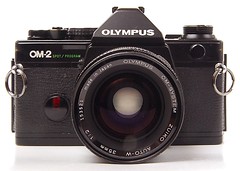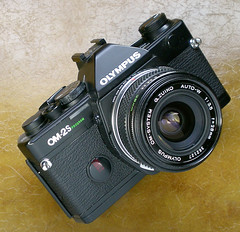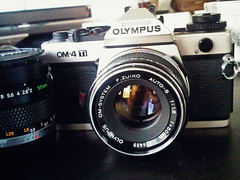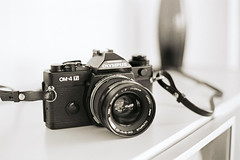Difference between revisions of "Olympus OM-1/2/3/4"
(→Links) |
Hanskerensky (talk | contribs) (Added link to user manual page) |
||
| (157 intermediate revisions by 23 users not shown) | |||
| Line 1: | Line 1: | ||
| − | The [[Olympus OM]] | + | The [[Olympus OM system|OM-System]] was introduced by [[Olympus]] in 1972, more than a decade later than most of the, by then, well-established 35mm SLR brands. Its success must undoubtedly be attributed to Olympus’ chief designer [[Maitani Yoshihisa]]{{Japanese name order}} and his staff, certainly taking advantage of new technology and increased general 35mm SLR understanding. The nucleus of this system is the brilliantly conceived camera body of remarkably compact design (small size was famously Maitani's signature), yet with one of best viewfinders in any 35mm SLR camera. The first model introduced was the all-mechanical M-1, soon renamed OM-1, with a full aperture [[TTL]] [[CdS]] exposure meter and a wide bayonet lens-mount, gradually complemented by several quite sophisticated models, most of them with electronic shutters and advanced auto-exposure. The system is also associated with one of the finest ranges of optics ever made available, the [[Olympus OM lenses|OM-System Zuiko lenses]], and a generous selection of accessories. |
| − | + | The Olympus OM-system camera range fall into two main groups of bodies, the ones discussed in this article, designated by one-digit model numbers; and the two-digit models intended as lower-cost alternatives, the [[Olympus OM-10/20/30/40|OM-10/20/30/40]], dealt with separately. | |
| − | + | {{Flickr_image | |
| + | |image_source= http://www.flickr.com/photos/martintaylor/45501182/in/pool-camerawiki | ||
| + | |image= http://farm1.static.flickr.com/31/45501182_d9cd52b82d_m.jpg | ||
| + | |image_align= right | ||
| + | |image_text= | ||
| + | |image_by= Martin Taylor | ||
| + | |image_rights= non-commercial | ||
| + | }} | ||
| − | The very first model was presented at | + | == OM-1 (M-1) == |
| + | {{Flickr_image | ||
| + | |image_source= http://www.flickr.com/photos/martintaylor/45323314/in/pool-camerawiki | ||
| + | |image= http://static.flickr.com/26/45323314_727f87d37b_m.jpg | ||
| + | |image_align= left | ||
| + | |image_text= Top view black OM-1 with winder | ||
| + | |image_by= Martin Taylor | ||
| + | |image_rights= non-commercial | ||
| + | }} | ||
| + | The very first model was presented at Photokina in Cologne in 1972<REF> Francesch, p. 167. </REF> and was called the '''Olympus M-1'''. Thirteen years earlier, the release of the [[Nikon F]] had done much to make the [[35mm]] [[SLR]] the standard choice for professionals and higher-spending amateurs who would previously have used [[Leica]] and other [[Rangefinder camera|rangefinders]], but it had driven the market towards heavy and bulky cameras. The Olympus M-1 changed this and with it began a reduction of size, weight and noise of the 35mm SLRs. It was designed by a team led by [[Maitani Yoshihisa]]{{Japanese name order}}, who had already created the [[Olympus Pen]] and [[Olympus Pen F|Pen F]] cameras, noted for their compactness. | ||
| − | Very soon a complaint from Leica forced Olympus to rename the M-1 to '''OM-1''', and apart from the name the two models are identical. Today bodies and lenses with the M name are | + | Very soon a complaint from Leica forced Olympus to rename the M-1 to '''OM-1''', and apart from the name the two models are identical. Today bodies and lenses with the M name are reputedly uncommon and are sought after by collectors. A rumour, usually attributed to the Olympus company, says that only 5,000 bodies were made.<REF> This rumour was relayed by a previous version of this very page, and might have started as a mistake on one of the Olympus official websites. </REF> However research by Mark Dapoz led to an actual production estimate of 52,000.<REF> [http://web.archive.org/web/20100527071557/http://olympus.dementia.org/M-1/ The Olympus M-1 Information Page The Olympus M-1 Information Page] by Mark Dapoz - retrieved from [http://www.archive.org Internet Archive The Wayback Machine] </REF> 25 examples of the M-1 were made in black finish.<ref>[http://web.archive.org/web/20090208015321/http://olympus.dementia.org/eSIF/om-sif/bodygroup/om1.htm this page of the OM Sales Information File - retrieved from [http://www.archive.org Internet Archive The Wayback Machine]</ref> |
| + | {{Flickr_image | ||
| + | |image_source= http://www.flickr.com/photos/martintaylor/45501196/in/pool-camerawiki | ||
| + | |image= http://static.flickr.com/33/45501196_7031279e86_m.jpg | ||
| + | |image_align= right | ||
| + | |image_text= | ||
| + | |image_by= Martin Taylor | ||
| + | |image_rights= non-commercial | ||
| + | }} | ||
| − | The OM-1 is an all mechanical | + | The OM-1 is an all-mechanical SLR. It has a very large viewfinder (allowing high eye relief if desired) with interchangeable screens but a fixed prism. It also has a through-the-lens exposure meter controlling a needle visible in the viewfinder. The camera does not have automatic exposure: the user has to use the aperture and speed rings to make a correct exposure. It has a very compact body, whose form was retained in later models. Unusually, the dial on top of the camera is only for film speed--shutter speed is set by a ring around the lens mount as on many leaf shutters. This would be standard for the single-digit OM series, as it allows the photographer's left hand to focus, adjust aperture and adjust shutter speed quickly without changing position. |
| − | Originally, | + | Originally, the oldest M-1 and OM-1 bodies would not accept motor drive. The bottom cover had to be replaced (meaning a new serial number) and the MD switch added to mount a motor or winder. The entire slow speed governor, along with some brass speed cams had to be replaced. Oldest OM-1 body castings required holes drilled in 2 locations. Newer "old" OM-1 might only require the addition of the md switch and new bottom cover (switch calibration required). In 1974 the '''OM-1MD''' was launched (MD standing for Motor Drive), to which a motor drive can be attached with no modification. This new version wears a small plate marked MD on the front. Oldest OM-1 MD had the MD sticker on the top cover, next to the rewind release lever. {{br}} |
| − | + | == OM-2 == | |
| + | {{Flickr_image | ||
| + | |image_source= http://www.flickr.com/photos/128971864@N07/33858901435/in/pool-camerawiki | ||
| + | |image= http://farm3.staticflickr.com/2877/33858901435_981bc8a597.jpg | ||
| + | |image_align= right | ||
| + | |image_text= OM-2 | ||
| + | |image_by= bigdark999 | ||
| + | |image_rights= with permission | ||
| + | }} | ||
| + | '''OM-2''' is the automatic version of the OM-1, presented officially in 1975 at the 31st Photo Salon in Paris. An OM-2 prototype was displayed in a showcase at the 1974 Photokina in Cologne, but none of its features were announced.<REF> ''Olympus OM-1 OM-2 OM-10 OM-1<small>N</small> OM-2<small>N</small>'', Éditions V.M., p. 12. </REF> Externally it is a close twin to the OM-1 (especially compared to later OM cameras) but the shutter is electronic and the exposure is either automatic ([[aperture priority]]) or metered-manual. As well, it introduces silicon blue diodes to the series--these are metering elements that operate faster than CdS cells and have a greater lens--this is necessary, as meter readings are taken very quickly in automatic mode.<ref>Nikon would start to use these from about '76 in their top-end cameras.</ref> | ||
| − | + | The camera has a four-way switch on the top plate which selects between three shooting modes and activates the battery check. There is a manual mode and two automatic modes: "manual" is center-the-needle metered-manual, "auto" mode has full aperture-priority AE with slow speeds, and when the switch is in "off" position, the shutter will still fire in aperture-priority mode, but with the speed limited to about 1/30th or above to save battery, and there will be no metering indication in the viewfinder -- this is because the OM-2 has two sets of metering cells: those used to passively indicate the exposure information to the photographer, and those which are active during aperture-priority operation. When the camera is "off," the former set of cells are deactivated, but the latter set will still be activated during exposure. | |
| − | The | + | The reason for the two sets of cells is this: while the former allow the exposure to be indicated for the photographer in both automatic and manual modes, the latter set actually determine the exact exposure in automatic mode. They are pointed backwards towards the shutter, and thus only operate while the mirror is up. The shutter curtain has a computer-generated pattern of white and black squares on it, representing an ideal weighting for a mathematically "average" photographic scene<ref>more precisely, the pattern was empirically tested and selected to give the best result in a wide variety of photographic situations, from a group of such computer-generated patterns.</ref>. Reflected light coming off this pattern allows the camera to meter the exposure when the mirror is up. When short speeds are indicated, the only significant metering is that done by reflected light off the curtain, as on the [[Leica M6]]. When longer speeds are indicated, (1/45th sec and longer) the camera will continue metering reflected light off the surface of the film and compensate for any variation of light; this is called off-the-film (OTF) metering. |
| − | + | There is a transparency held to one side of the focusing screen, with the shutter speed and two arrow marks which serves as the indicator for the meter needle: when in automatic mode, this transparency is slid mechanically all the way into frame and the needle shows the shutter speed that the preview cells anticipate will be selected. In manual mode, a small tab on the edge of the transparency is slid into the frame, showing the two arrow marks. Centering the needle between these two marks gives metered exposure using the preview cells, without involving the OTF cells. When the camera is in "off" mode, the needle is relaxed and the transparency is slid completely out of sight. | |
| − | |||
| − | |||
| − | + | A small light on the back of the camera lights when the switch is pushed past "auto" into "check," assuming the batteries are fresh. | |
| − | + | ||
| − | + | There is no AE lock for backlighting compensation--instead, the dial on top of the camera has been replaced with an exposure compensation dial (the film speed is set by a smaller dial inside this one, as on the shutter speed dials of many SLR's) which essentially allows the photographer to change the the metered film speed without losing track of the actual film speed. This is often necessary for backlit subjects in conditions where it is inconvenient to use manual mode. By overexposing a full stop from the metered exposure, a moderately backlit subject will be brought back into correct exposure. | |
| − | + | ||
| − | + | Manual mode is identical in functionality to the OM-1, in that the needle will be centered between two marks when the combination of aperture and shutter speed matches the average light level of the scene (the compensation will still be applied). The camera meters wide open in this mode. | |
| + | |||
| + | If the film is advanced while the shutter is open, the shutter will close and the mirror will lock up to indicate that there has been an error. If the mirror is locked up the shutter can be reset and the mirror unlocked by pushing the shutter dial past B to the "reset" position. This only applies to this original model of OM-2 (see below). | ||
| + | |||
| + | The exposure sensor also controls the flash exposure when using a compatible flash; this is called through-the-lens ([[TTL]]) flash automation or OTF flash exposure. | ||
| + | |||
| + | The OM-2 was the first camera to have OTF metering of any kind (a Minolta patent licensed to Olympus). The TTL flash automation greatly simplifies flash exposure, and was quickly adopted by most other SLR camera makers, while OTF metering was also adopted by some competitors, like the [[Pentax LX]]. The Olympus Quick Auto 310 flashgun was designed for the OM-2, which unfortunately is not compatible with the T series flash units introduced in 1979 together with the new OM-1n and OM-2n. | ||
| + | {{br}} | ||
| + | |||
| + | == OM-1<small>N</small> and OM-2<small>N</small> == | ||
| − | + | {{Flickr_image | |
| + | |image_source= http://www.flickr.com/photos/98922823@N00/8677889399/in/pool-camerawiki/ | ||
| + | |image= http://farm9.staticflickr.com/8113/8677889399_2caec99a3c_m.jpg | ||
| + | |image_align= right | ||
| + | |image_text= OM-2<small>N</small> black | ||
| + | |image_by= Paulo Moreira | ||
| + | |image_rights= wp | ||
| + | }} | ||
| − | == The OM- | + | The '''OM-1<small>N</small>''' is a revised OM-1. It is the same as the original with the following modifications: |
| + | * redesigned film advance lever | ||
| + | * flash ready/sufficient LED in the viewfinder | ||
| + | <div class="floatleft plainlinks" style="margin:0px 25px 0px 0px;"> | ||
| + | {{Flickr_image | ||
| + | |image_source= http://www.flickr.com/photos/rhettredelings/2080286004/in/pool-camerawiki | ||
| + | |image= http://farm3.static.flickr.com/2070/2080286004_1113196e83_m.jpg | ||
| + | |image_align= left | ||
| + | |image_text= OM-2N top | ||
| + | |image_by= Rhett Redelings | ||
| + | |image_rights= with permission | ||
| + | }} | ||
| + | </div> | ||
| + | The '''OM-2<small>N</small>''', based on the OM-2, has the same modifications plus: | ||
| + | * Shutter reset moved to the on/auto/manual/check switch (same position as battery check). | ||
| + | * a direct contact inside for Recordata backs | ||
| + | * an exposure compensation warning flag (this appears in the viewfinder frame near the meter indicator when the compensation dial is turned from +/- 0.) | ||
| + | * full-frame averaging at all shutter speeds | ||
| + | * 120 second exposure limit on auto, though in practice, low light exposures will often go to 3.5 minutes (the OM-2 limit was listed as 60 seconds in the instruction book, but at asa 12 would go as long as 19 minutes while at asa 1600 would end in as little as 19 ''seconds'')<ref>The limits here are to do with the limitations of the silicon blue meter diodes, which can only meaningfully meter within a certain range.</ref>. | ||
| − | + | All these models existed in chrome or black, and there was also a gold version of the OM-1n. | |
| + | {{br}} | ||
| − | The '''OM-2SP''' was introduced in | + | == OM-2SP / OM-2S == |
| + | {|class=floatright | ||
| + | | | ||
| + | {{Flickr_image | ||
| + | |image_source= http://www.flickr.com/photos/martintaylor/44931866/in/pool-camerawiki | ||
| + | |image= http://static.flickr.com/24/44931866_d7b07432e2_m.jpg | ||
| + | |image_align= right | ||
| + | |image_text= OM-2SP | ||
| + | |image_by= Martin Taylor | ||
| + | |image_rights= non-commercial | ||
| + | }} | ||
| + | |- | ||
| + | | | ||
| + | {{Flickr_image | ||
| + | |image_source= http://www.flickr.com/photos/casualcameracollector/4375577781/in/pool-camerawiki/ | ||
| + | |image= http://farm3.staticflickr.com/2717/4375577781_631cf8aa5c_m.jpg | ||
| + | |image_align= | ||
| + | |image_text= OM-2S | ||
| + | |image_by= Casual Camera Collector | ||
| + | |image_rights= with permission | ||
| + | }} | ||
| + | |} | ||
| + | The '''OM-2SP''' was introduced in 1984, after the OM-3 and OM-4. In some markets, it was called '''OM-2S'''. Although its name suggests it is a continuation of the OM-2, it has more in common with the OM-4 (and is built on the OM-4 body castings). Due to the governor built into the mirror mechanism (which is key to proper functioning of program mode), camera firing speed with either Motor Drive 1 or 2 is lowered to about 3.5 fps. | ||
Compared to the OM-2n, the OM-2SP adds: | Compared to the OM-2n, the OM-2SP adds: | ||
| − | * programmed exposure automation (camera chooses both aperture and shutter speed), added to the aperture priority and manual modes | + | * programmed exposure automation (camera chooses both aperture and shutter speed), added to the aperture priority and manual modes. |
| − | * a spot meter for use in manual mode | + | * a spot meter for use in manual mode. |
| − | * a slightly modified body, with | + | * a slightly modified body, with a fixed hot shoe. |
| − | * the ISO range is extended from 1600 to 3200 | + | * the ISO range is extended from 1600 to 3200. |
| − | * the viewfinder indicators are LCDs | + | * the viewfinder indicators are LCDs. |
| + | * the viewfinder is illuminated via a display window or via a small lamp. | ||
* the self timer has mirror prefire. | * the self timer has mirror prefire. | ||
The OM-2SP / OM-2S only existed in black. | The OM-2SP / OM-2S only existed in black. | ||
| + | {{br}} | ||
| + | == OM-4 == | ||
| + | {{Flickr_image | ||
| + | |image_source= http://www.flickr.com/photos/41123478@N03/5736384971/in/pool-camerawiki/ | ||
| + | |image= http://farm6.static.flickr.com/5149/5736384971_5cf1128f08_m.jpg | ||
| + | |image_align= right | ||
| + | |image_text=OM-4 | ||
| + | |image_by= Hospice of St Francis | ||
| + | |image_rights= with permission | ||
| + | }} | ||
| − | + | The '''OM-4''' is the top-of-the-line body with shutter speeds up to 1/2000, released in 1983. The body is built on an all-new aluminum casting, with a new type of viewfinder including [[diopter|dioptric correction]]. With this camera Olympus introduced a new, versatile light-metering system. Besides the normal center-weighted metering the camera is equipped with a "Multi Spot" metering system that allows storage of up to eight measurements on a 2% central spot before making an exposure. The camera's computer electronics calculate the mean of the memorized light values to determine the optimal shutter speed. If desired, the calculated value can be retained for several exposures by using a "Memo" switch. There are also two "Hi Light" and "Shadow" buttons that are used only with spot metering. The "Hi Light" button applies an exposure correction of +2 EV, and is used when taking a spot reading on a light-tone subject for a high-key picture. The "Shadow" button applies the opposite correction of -2<sup>1</sup>/<sub>3</sub> EV to a spot reading on a dark-tone subject, to obtain a low-key picture. In addition, there is an ordinary exposure correction knob, under the rewind knob, that will work for both average and spot measures. The LCD display, visible at the bottom of the viewfinder, shows the shutter speed and the average or spot measures. It also reminds the user when any of the features described above are activated ("Spot", "Memo", "Hi Light", "Shadow" and/or exposure correction). An additional green light indicates that a dedicated flash is attached and ready for use. | |
| − | The | + | The OM-4 was released at about the same time as the [[Nikon FA]] which introduced matrix metering. The two systems were innovative, but quite different: the OM-4 provides spot measurements and does the necessary computations, but it lets the photographer determine how he wants the picture to be exposed, while the FA compares the light pattern of the picture with a databank of commonly-occurring photographic situations, allowing the photographer to work faster and even palliating his knowledge deficiencies and actually beginning to think for him. (Nikon's approach was the one that would prevail among future 35mm and digital SLRs.) Among the few cameras to have a multi-spot metering system after the OM-4 were the Hasselblad 205 FCC and the Rollei 6008, some of the most expensive medium format cameras. |
| − | + | == OM-3 == | |
| − | + | {{Flickr_image | |
| + | |image_source= http://www.flickr.com/photos/wolf-t/5828359616/in/pool-camerawiki/ | ||
| + | |image= http://farm4.staticflickr.com/3312/5828359616_a78264273b_m.jpg | ||
| + | |image_align= right | ||
| + | |image_text= OM-3 | ||
| + | |image_by= wolf4max | ||
| + | |image_rights= nc | ||
| + | }} | ||
| − | + | The '''OM-3''', released in 1984, is a mechanical version of the OM-4, with the same metering system but with a mechanical shutter, without automatic shutter speed exposure control governed by the metering system. It has no TTL flash automation, and no self-timer. It did not sell in great quantities, and was dropped in 1986. People wanting a mechanical camera would rather choose the OM-1n, available at least until 1987, or the OM-4 if requiring the multi-spot metering system. In consequence, it is scarce and the second hand asking price greatly exceeds that of the OM-4. | |
| − | + | Both the OM-3 and the OM-4 were only available in black. | |
| + | {{br}} | ||
| − | The '''OM-4Ti''' was released in 1987 and replaced the OM-4. | + | == OM-3Ti / OM-3T and OM-4Ti / OM-4T == |
| + | {|class=floatright | ||
| + | || | ||
| + | {{Flickr_image | ||
| + | |image_source= http://www.flickr.com/photos/patrickbraun/5212436117/in/pool-camerawiki/ | ||
| + | |image= http://farm5.staticflickr.com/4108/5212436117_ed3387834a_m.jpg | ||
| + | |image_align= right | ||
| + | |image_text= champagne OM-4 Ti | ||
| + | |image_by= Patrick Braun | ||
| + | |image_rights= with permission | ||
| + | }} | ||
| + | |- | ||
| + | | | ||
| + | {{Flickr_image | ||
| + | |image_source= http://www.flickr.com/photos/msokal/3827392434/in/pool-camerawiki/ | ||
| + | |image= http://farm3.staticflickr.com/2450/3827392434_1fd4e4f970_m.jpg | ||
| + | |image_align= | ||
| + | |image_text= OM-4 T | ||
| + | |image_by= Marcello Sokal | ||
| + | |image_rights= with permission | ||
| + | }} | ||
| + | |- | ||
| + | | | ||
| + | {{Flickr_image | ||
| + | |image_source= http://www.flickr.com/photos/patrickbraun/5281227361/in/pool-camerawiki/ | ||
| + | |image= http://farm6.staticflickr.com/5006/5281227361_447868c370_m.jpg | ||
| + | |image_align= Right | ||
| + | |image_text= Black OM-4Ti | ||
| + | |image_by= Patrick Braun | ||
| + | |image_rights= with permission | ||
| + | }} | ||
| + | |} | ||
| + | The '''OM-4Ti''' was released in 1987 and replaced the OM-4. In the United States, it is known as the '''4T''', while 4Ti is used for the rest of the world. In the US, when repair parts supply of '''4T''' top covers ran out, '''4Ti''' tops were substituted. It has the same body as the OM-4 except it has titanium top cover, bottom cover and trim behind the shutter speed dial. It featured full-synchro integration with the stroboscopic [[Olympus_OM_system#Flash_group|F280 flash unit]], allowing flash pictures beyond the X sync speed, up to a maximum of 1/2000 sec. This system was called Super FP sync, and was first featured on the [[Olympus_OM-707|OM-707]]. It was an answer to one of the OM's weaknesses: the low X sync speed of 1/60. | ||
| − | The OM-4Ti was released first with a champagne finish, and later in a black finish. | + | The OM-4Ti was released first with a champagne finish, and later in a black finish. Production ended in 2003. |
| − | The '''OM-3Ti''' is | + | The '''OM-3Ti''', released in 1994, is an updated edition of the mechanical body OM-3 produced until 1986. It has the all-mechanical shutter of the OM-3, while its titanium top and bottom covers and some other features is from the OM-4Ti. It has TTL flash automation, itself a rare feature on a mechanical body. It also has the same high-speed flash support as the OM-4Ti. |
| − | + | The United States distributor also sold the '''OM-3Ti'''. There was no '''OM-3T'''. The '''OM-3Ti''' is the last of the 'true' OM series (the [[Olympus_OM2000|OM-2000]] followed in 1997, but it was made for Olympus by [[Cosina]] and was not a true [[Olympus_OM_system|OM system]] camera). | |
| − | |||
| − | + | <!--Commented out image, no longer available on Flickr, please remove if not returned by 11/2022 {{Flickr_image | |
| + | |image_source= http://www.flickr.com/photos/boochap/3472959698/in/pool-camerawiki/ | ||
| + | |image= http://farm4.staticflickr.com/3570/3472959698_5af5c26d66_m.jpg | ||
| + | |image_align= | ||
| + | |image_text= OM-3 Ti | ||
| + | |image_by= boochap | ||
| + | |image_rights= with permission | ||
| + | }} --> | ||
| − | + | {{br}} | |
| − | |||
| − | |||
| − | |||
| − | |||
| − | == | + | == The OM-X / MDN == |
| − | + | During the design study of the OM-1, the Olympus design team led by [[Maitani Yoshihisa]]{{Japanese name order}} had worked on a completely modular camera: a 35mm equivalent of a [[Hasselblad]], consisting of a mirror box with interchangable backs as well as finders and so forth. This extraordinary camera was built as a prototype, and was called the '''MDN''' and later the '''OM-X'''<ref name = "OMX">[http://web.archive.org/web/20091027105309/http://geocities.com/maitani_fan/om_interview_2.html Maitani interview] retrieved from [http://www.archive.org Internet Archive The Wayback Machine] - Oct, 2009 capture.</ref><ref name = "Dream">[http://web.archive.org/web/20091022060641/http://geocities.com/maitani_fan2/omx.html OM-X: The Dream System] retrieved from [http://www.archive.org Internet Archive The Wayback Machine] - Sept, 2008 capture</ref>. | |
| − | |||
| − | |||
| − | |||
| − | |||
| − | |||
| − | == | + | ==Timeline== |
| − | + | {{Olympus OM timeline}} | |
| − | |||
| − | |||
| − | |||
| − | == | + | == Notes == |
| − | + | <references /> | |
== Bibliography == | == Bibliography == | ||
| − | * '' | + | * {{Francesch Olympus}} |
| + | * ''Olympus OM-1 OM-2 OM-10 OM-1<small>N</small> OM-2<small>N</small>'', Ronan Loaëc, Michel de Ferrières, Jean-Maurice Corrèze, supervised by Gérard Bouhot, with the participation of Francis Delvert, 2nd edition revised by Serge Bergal, 1980, published by Éditions V.M., Paris, <nowiki>ISBN</nowiki> 2-86257-021-X | ||
| + | |||
| + | == Links == | ||
| + | === General links === | ||
| + | In English: | ||
| + | *[https://web.archive.org/web/20170319222030/http://www.olympus-global.com/en/corc/history/camera/1973/ OM-1], [https://web.archive.org/web/20170312062018/http://www.olympus-global.com/en/corc/history/camera/1975/ OM-2] and [https://web.archive.org/web/20170103080852/http://www.olympus-global.com/en/corc/history/camera/1986/ OM-4 Ti] at the [https://web.archive.org/web/20170117071606/http://www.olympus-global.com/en/corc/history/ Olympus Global Camera Museum] (archived) | ||
| + | * [http://esif.world-traveller.org/om-sif.htm The Unofficial Olympus OM Sales Information File] describes every part of the OM system | ||
| + | * [http://web.archive.org/web/20100527071557/http://olympus.dementia.org/M-1/ The Olympus M-1 Information Page] by Mark Dapoz - retrieved from [http://www.archive.org Internet Archive The Wayback Machine] | ||
| + | * [http://www.mir.com.my/rb/photography/hardwares/classics/olympusom1n2/index.htm OM-1<small>N</small>, OM-2<small>N</small> and OM-2SP Modern Classics] at [http://www.mir.com.my/rb/photography/photography.htm Photography in Malaysia] | ||
| + | * [http://esif.world-traveller.org/oly_faq.htm OM SLR FAQ] by R. Lee Hawkins | ||
| + | * [http://www.maitani-fan.com/index.html Maitani Fan website] by Chris Lee, with some details about the OM-X | ||
| + | * [http://www.ne.jp/asahi/japan/manual-camera/m11.htm M-1], [http://www.ne.jp/asahi/japan/manual-camera/om11.htm OM-1], [http://www.ne.jp/asahi/japan/manual-camera/om3b1.htm OM-3], [http://www.ne.jp/asahi/japan/manual-camera/om3ti1.htm OM-3Ti] and [http://www.ne.jp/asahi/japan/manual-camera/om4ti1.htm OM-4Ti] at N. Maekawa's [http://www.ne.jp/asahi/japan/manual-camera/ Manual Camera website] (the main page is in Japanese) | ||
| + | * [http://www.thecamerasite.lauro.fi/01_SLR_Cameras/Pages/olympus1.htm OM-1], [http://www.thecamerasite.lauro.fi/01_SLR_Cameras/Pages/olympus2.htm OM-2S] and [http://www.thecamerasite.lauro.fi/01_SLR_Cameras/Pages/olympus4.htm OM-4] at [http://www.thecamerasite.lauro.fi/ Reijo Lauro's camera site] | ||
| + | *[http://camarasclassicas.blogspot.com/2010/09/yoshihisa-maitani-and-cult-of-olympus.html Yoshihisa Maitani and the cult of Olympus] at [http://camarasclassicas.blogspot.com/ Classic Cameras] by RaúlM. | ||
| + | * Early review [http://books.google.com/books?id=5gxIBYlChPwC&lpg=PA67&dq=%22Olympus%20OM-1%22&pg=PA67#v=twopage&q=%22OM-1:%20Littlest%20Full-Size%20SLR%20Around%22&f=false "OM-1: Littlest Full-Size SLR Around"] by Paul Wahl in ''Popular Science'' magazine (USA) August 1973; from [http://books.google.com/books Google Books] | ||
| + | In French: | ||
| + | * [http://35mm-compact.com/reflex/olympusom1.htm OM-1], [http://35mm-compact.com/reflex/olympusom1n.htm OM-1<small>N</small>], [http://35mm-compact.com/reflex/olympusom2n.htm OM-2<small>N</small>] and [http://35mm-compact.com/reflex/olympusom4.htm OM-4] at Lionel's [http://35mm-compact.com/ 35mm-compact.com] | ||
| + | * [http://www.collection-appareils.fr/x/html/page_standard.php?id_appareil=12510 OM-1], [http://www.collection-appareils.fr/x/html/page_standard.php?id_appareil=11631 OM-1 MD], [http://www.collection-appareils.fr/x/html/page_standard.php?id_appareil=11632 OM-1n MD], [http://www.collection-appareils.fr/x/html/page_standard.php?id_appareil=11633 OM-1n MD], [http://www.collection-appareils.fr/x/html/page_standard.php?id_appareil=11634 OM-2], [http://www.collection-appareils.fr/x/html/page_standard.php?id_appareil=12155 OM-2s], [http://www.collection-appareils.fr/x/html/page_standard.php?id_appareil=12502 OM-2sp], [http://www.collection-appareils.fr/x/html/page_standard.php?id_appareil=11635 OM-2n], [http://www.collection-appareils.fr/x/html/page_standard.php?id_appareil=11636 OM-2n], [http://www.collection-appareils.fr/x/html/page_standard.php?id_appareil=11637 OM-4 Ti] at [http://www.collection-appareils.fr/general/html/francais.php Collection Appareils] by Sylvain Halgand | ||
| + | In Spanish: | ||
| + | * [http://www.hugorodriguez.com/articulos/olympusom1.htm OM-1] and [http://www.hugorodriguez.com/articulos/olympusom4ti.htm OM-4Ti] in the [http://www.hugorodriguez.com/ website of Hugo Rodriguez] | ||
| + | In Japanese: | ||
| + | * [http://www.pluto.dti.ne.jp/~masaki-k/camera%20OlympusOM1.htm OM-1] at [http://www.pluto.dti.ne.jp/~masaki-k/newpage2.htm La Chambre Claire] | ||
| + | * [https://web.archive.org/web/20200206064928/http://ko-ga.image.coocan.jp/Camera/Lost/index_Lostcamera.html Olympus Cameras (amongst others)] by Tomoyuki Shimizu (archived) | ||
| + | |||
| + | === Literature and manuals === | ||
| + | In English: | ||
| + | *[https://www.butkus.org/chinon/olympus/olympus_om-1/olympus_om-1.htm Olympus OM-1 user manual] at [https://www.butkus.org/chinon/ Butkus.org] | ||
| + | *[https://www.butkus.org/chinon/olympus/olympus_om-2/olympus_om-2.htm Olympus OM-2 user manual] at [https://www.butkus.org/chinon/ Butkus.org] | ||
| + | *[https://www.manualslib.com/products/Olympus-Om-3-3999356.html Olympus OM-3 user manual] at [https://www.manualslib.com/ Manualslib] | ||
| + | *[https://www.butkus.org/chinon/olympus/olympus_om-3ti/olympus_om-3ti.htm Olympus OM-3Ti user manual] at [https://www.butkus.org/chinon/ Butkus.org] | ||
| + | *[https://www.manualslib.com/products/Olympus-Om-4-3967038.html Olympus OM-4 user manual] at [https://www.manualslib.com/ Manualslib] | ||
| + | *[https://www.butkus.org/chinon/olympus/olympus_om-4_ti/olympus_om-4_ti.htm Olympus OM-4Ti user manual] at [https://www.butkus.org/chinon/ Butkus.org] | ||
| + | * US patent 4137539 by Olympus, 1979: "[https://worldwide.espacenet.com/publicationDetails/originalDocument?CC=US&NR=4137539A&KC=A&FT=D&ND=&date=19790130&DB=&locale=en_EP# Single lens reflex camera]" describing the OM-1; at [https://worldwide.espacenet.com/ Espacenet] | ||
| + | * [http://web.archive.org/web/20050103001903/http://www.nadir.it/ob-fot_piccolo/olympus_om4/test-modern.htm A 1983 test of the OM-4 in the Italian magazine Reflex], available at the [http://www.nadir.it/index.htm Nadir Magazine website] - retrieved from [http://www.archive.org Internet Archive The Wayback Machine] | ||
| + | |||
| + | === Repairs === | ||
| + | * [http://web.archive.org/web/20090203132424/http://olympus.dementia.org/Hardware/ The Olympus Hardware Resource Page — online repair manuals], provided by Mark Dapoz, including tutorials for [http://web.archive.org/web/20081007001325/http://olympus.dementia.org/Hardware/tutorials/OM-1CoverRemoval/ top cover removal] and [http://web.archive.org/web/20090529003345/http://olympus.dementia.org/Hardware/tutorials/FoamRemoval/ prism foam replacement] - retrieved from [http://www.archive.org Internet Archive The Wayback Machine] | ||
| + | * [http://photographic.co.nz/cameraworks/cameras/om1_shutter OM-1 Repair — Basic shutter job] in [http://photographic.co.nz/cameraworks/Default.htm Robert Ian Axford's Camera-Works] | ||
| + | * [http://www.zuiko.com/ John Hermanson's Olympus OM Service] | ||
{{olympus classic}} | {{olympus classic}} | ||
| − | + | [[Category: Japanese 35mm SLR]] | |
| − | [[Category: 35mm SLR]] | + | [[Category: Olympus OM mount]] |
| − | [[Category: | + | [[Category: Olympus|OM-1]] |
| − | [[Category: Olympus]] | + | [[Category: O|OM-1 Olympus]] |
| − | [[Category: O]] | ||
Revision as of 08:07, 11 November 2021
The OM-System was introduced by Olympus in 1972, more than a decade later than most of the, by then, well-established 35mm SLR brands. Its success must undoubtedly be attributed to Olympus’ chief designer Maitani Yoshihisa[1] and his staff, certainly taking advantage of new technology and increased general 35mm SLR understanding. The nucleus of this system is the brilliantly conceived camera body of remarkably compact design (small size was famously Maitani's signature), yet with one of best viewfinders in any 35mm SLR camera. The first model introduced was the all-mechanical M-1, soon renamed OM-1, with a full aperture TTL CdS exposure meter and a wide bayonet lens-mount, gradually complemented by several quite sophisticated models, most of them with electronic shutters and advanced auto-exposure. The system is also associated with one of the finest ranges of optics ever made available, the OM-System Zuiko lenses, and a generous selection of accessories.
The Olympus OM-system camera range fall into two main groups of bodies, the ones discussed in this article, designated by one-digit model numbers; and the two-digit models intended as lower-cost alternatives, the OM-10/20/30/40, dealt with separately.
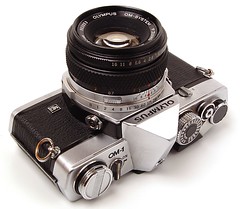
|
| image by Martin Taylor (Image rights) |
Contents
OM-1 (M-1)
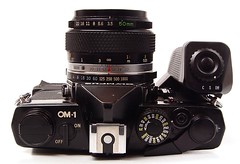
|
| Top view black OM-1 with winder image by Martin Taylor (Image rights) |
The very first model was presented at Photokina in Cologne in 1972[2] and was called the Olympus M-1. Thirteen years earlier, the release of the Nikon F had done much to make the 35mm SLR the standard choice for professionals and higher-spending amateurs who would previously have used Leica and other rangefinders, but it had driven the market towards heavy and bulky cameras. The Olympus M-1 changed this and with it began a reduction of size, weight and noise of the 35mm SLRs. It was designed by a team led by Maitani Yoshihisa[1], who had already created the Olympus Pen and Pen F cameras, noted for their compactness.
Very soon a complaint from Leica forced Olympus to rename the M-1 to OM-1, and apart from the name the two models are identical. Today bodies and lenses with the M name are reputedly uncommon and are sought after by collectors. A rumour, usually attributed to the Olympus company, says that only 5,000 bodies were made.[3] However research by Mark Dapoz led to an actual production estimate of 52,000.[4] 25 examples of the M-1 were made in black finish.[5]
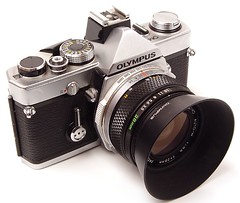
|
| image by Martin Taylor (Image rights) |
The OM-1 is an all-mechanical SLR. It has a very large viewfinder (allowing high eye relief if desired) with interchangeable screens but a fixed prism. It also has a through-the-lens exposure meter controlling a needle visible in the viewfinder. The camera does not have automatic exposure: the user has to use the aperture and speed rings to make a correct exposure. It has a very compact body, whose form was retained in later models. Unusually, the dial on top of the camera is only for film speed--shutter speed is set by a ring around the lens mount as on many leaf shutters. This would be standard for the single-digit OM series, as it allows the photographer's left hand to focus, adjust aperture and adjust shutter speed quickly without changing position.
Originally, the oldest M-1 and OM-1 bodies would not accept motor drive. The bottom cover had to be replaced (meaning a new serial number) and the MD switch added to mount a motor or winder. The entire slow speed governor, along with some brass speed cams had to be replaced. Oldest OM-1 body castings required holes drilled in 2 locations. Newer "old" OM-1 might only require the addition of the md switch and new bottom cover (switch calibration required). In 1974 the OM-1MD was launched (MD standing for Motor Drive), to which a motor drive can be attached with no modification. This new version wears a small plate marked MD on the front. Oldest OM-1 MD had the MD sticker on the top cover, next to the rewind release lever.
OM-2
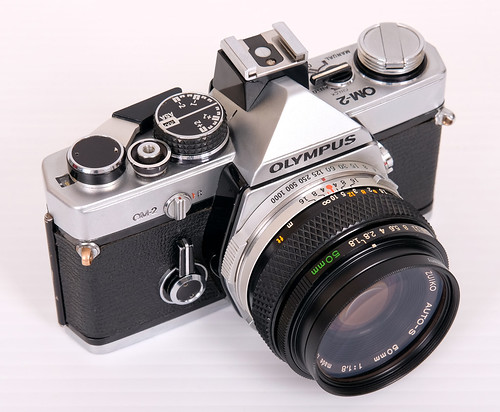
|
| OM-2 image by bigdark999 (Image rights) |
OM-2 is the automatic version of the OM-1, presented officially in 1975 at the 31st Photo Salon in Paris. An OM-2 prototype was displayed in a showcase at the 1974 Photokina in Cologne, but none of its features were announced.[6] Externally it is a close twin to the OM-1 (especially compared to later OM cameras) but the shutter is electronic and the exposure is either automatic (aperture priority) or metered-manual. As well, it introduces silicon blue diodes to the series--these are metering elements that operate faster than CdS cells and have a greater lens--this is necessary, as meter readings are taken very quickly in automatic mode.[7]
The camera has a four-way switch on the top plate which selects between three shooting modes and activates the battery check. There is a manual mode and two automatic modes: "manual" is center-the-needle metered-manual, "auto" mode has full aperture-priority AE with slow speeds, and when the switch is in "off" position, the shutter will still fire in aperture-priority mode, but with the speed limited to about 1/30th or above to save battery, and there will be no metering indication in the viewfinder -- this is because the OM-2 has two sets of metering cells: those used to passively indicate the exposure information to the photographer, and those which are active during aperture-priority operation. When the camera is "off," the former set of cells are deactivated, but the latter set will still be activated during exposure.
The reason for the two sets of cells is this: while the former allow the exposure to be indicated for the photographer in both automatic and manual modes, the latter set actually determine the exact exposure in automatic mode. They are pointed backwards towards the shutter, and thus only operate while the mirror is up. The shutter curtain has a computer-generated pattern of white and black squares on it, representing an ideal weighting for a mathematically "average" photographic scene[8]. Reflected light coming off this pattern allows the camera to meter the exposure when the mirror is up. When short speeds are indicated, the only significant metering is that done by reflected light off the curtain, as on the Leica M6. When longer speeds are indicated, (1/45th sec and longer) the camera will continue metering reflected light off the surface of the film and compensate for any variation of light; this is called off-the-film (OTF) metering.
There is a transparency held to one side of the focusing screen, with the shutter speed and two arrow marks which serves as the indicator for the meter needle: when in automatic mode, this transparency is slid mechanically all the way into frame and the needle shows the shutter speed that the preview cells anticipate will be selected. In manual mode, a small tab on the edge of the transparency is slid into the frame, showing the two arrow marks. Centering the needle between these two marks gives metered exposure using the preview cells, without involving the OTF cells. When the camera is in "off" mode, the needle is relaxed and the transparency is slid completely out of sight.
A small light on the back of the camera lights when the switch is pushed past "auto" into "check," assuming the batteries are fresh.
There is no AE lock for backlighting compensation--instead, the dial on top of the camera has been replaced with an exposure compensation dial (the film speed is set by a smaller dial inside this one, as on the shutter speed dials of many SLR's) which essentially allows the photographer to change the the metered film speed without losing track of the actual film speed. This is often necessary for backlit subjects in conditions where it is inconvenient to use manual mode. By overexposing a full stop from the metered exposure, a moderately backlit subject will be brought back into correct exposure.
Manual mode is identical in functionality to the OM-1, in that the needle will be centered between two marks when the combination of aperture and shutter speed matches the average light level of the scene (the compensation will still be applied). The camera meters wide open in this mode.
If the film is advanced while the shutter is open, the shutter will close and the mirror will lock up to indicate that there has been an error. If the mirror is locked up the shutter can be reset and the mirror unlocked by pushing the shutter dial past B to the "reset" position. This only applies to this original model of OM-2 (see below).
The exposure sensor also controls the flash exposure when using a compatible flash; this is called through-the-lens (TTL) flash automation or OTF flash exposure.
The OM-2 was the first camera to have OTF metering of any kind (a Minolta patent licensed to Olympus). The TTL flash automation greatly simplifies flash exposure, and was quickly adopted by most other SLR camera makers, while OTF metering was also adopted by some competitors, like the Pentax LX. The Olympus Quick Auto 310 flashgun was designed for the OM-2, which unfortunately is not compatible with the T series flash units introduced in 1979 together with the new OM-1n and OM-2n.
OM-1N and OM-2N
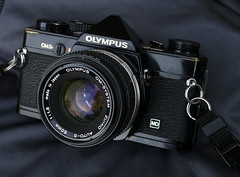
|
| OM-2N black image by Paulo Moreira (Image rights) |
The OM-1N is a revised OM-1. It is the same as the original with the following modifications:
- redesigned film advance lever
- flash ready/sufficient LED in the viewfinder
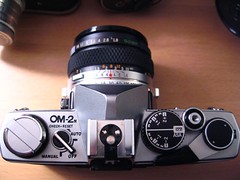
|
| OM-2N top image by Rhett Redelings (Image rights) |
The OM-2N, based on the OM-2, has the same modifications plus:
- Shutter reset moved to the on/auto/manual/check switch (same position as battery check).
- a direct contact inside for Recordata backs
- an exposure compensation warning flag (this appears in the viewfinder frame near the meter indicator when the compensation dial is turned from +/- 0.)
- full-frame averaging at all shutter speeds
- 120 second exposure limit on auto, though in practice, low light exposures will often go to 3.5 minutes (the OM-2 limit was listed as 60 seconds in the instruction book, but at asa 12 would go as long as 19 minutes while at asa 1600 would end in as little as 19 seconds)[9].
All these models existed in chrome or black, and there was also a gold version of the OM-1n.
OM-2SP / OM-2S
| ||
|
The OM-2SP was introduced in 1984, after the OM-3 and OM-4. In some markets, it was called OM-2S. Although its name suggests it is a continuation of the OM-2, it has more in common with the OM-4 (and is built on the OM-4 body castings). Due to the governor built into the mirror mechanism (which is key to proper functioning of program mode), camera firing speed with either Motor Drive 1 or 2 is lowered to about 3.5 fps.
Compared to the OM-2n, the OM-2SP adds:
- programmed exposure automation (camera chooses both aperture and shutter speed), added to the aperture priority and manual modes.
- a spot meter for use in manual mode.
- a slightly modified body, with a fixed hot shoe.
- the ISO range is extended from 1600 to 3200.
- the viewfinder indicators are LCDs.
- the viewfinder is illuminated via a display window or via a small lamp.
- the self timer has mirror prefire.
The OM-2SP / OM-2S only existed in black.
OM-4
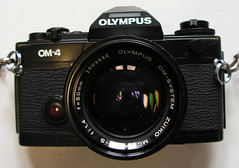
|
| OM-4 image by Hospice of St Francis (Image rights) |
The OM-4 is the top-of-the-line body with shutter speeds up to 1/2000, released in 1983. The body is built on an all-new aluminum casting, with a new type of viewfinder including dioptric correction. With this camera Olympus introduced a new, versatile light-metering system. Besides the normal center-weighted metering the camera is equipped with a "Multi Spot" metering system that allows storage of up to eight measurements on a 2% central spot before making an exposure. The camera's computer electronics calculate the mean of the memorized light values to determine the optimal shutter speed. If desired, the calculated value can be retained for several exposures by using a "Memo" switch. There are also two "Hi Light" and "Shadow" buttons that are used only with spot metering. The "Hi Light" button applies an exposure correction of +2 EV, and is used when taking a spot reading on a light-tone subject for a high-key picture. The "Shadow" button applies the opposite correction of -21/3 EV to a spot reading on a dark-tone subject, to obtain a low-key picture. In addition, there is an ordinary exposure correction knob, under the rewind knob, that will work for both average and spot measures. The LCD display, visible at the bottom of the viewfinder, shows the shutter speed and the average or spot measures. It also reminds the user when any of the features described above are activated ("Spot", "Memo", "Hi Light", "Shadow" and/or exposure correction). An additional green light indicates that a dedicated flash is attached and ready for use.
The OM-4 was released at about the same time as the Nikon FA which introduced matrix metering. The two systems were innovative, but quite different: the OM-4 provides spot measurements and does the necessary computations, but it lets the photographer determine how he wants the picture to be exposed, while the FA compares the light pattern of the picture with a databank of commonly-occurring photographic situations, allowing the photographer to work faster and even palliating his knowledge deficiencies and actually beginning to think for him. (Nikon's approach was the one that would prevail among future 35mm and digital SLRs.) Among the few cameras to have a multi-spot metering system after the OM-4 were the Hasselblad 205 FCC and the Rollei 6008, some of the most expensive medium format cameras.
OM-3
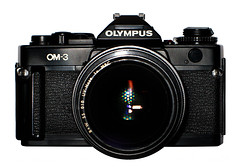
|
| OM-3 image by wolf4max (Image rights) |
The OM-3, released in 1984, is a mechanical version of the OM-4, with the same metering system but with a mechanical shutter, without automatic shutter speed exposure control governed by the metering system. It has no TTL flash automation, and no self-timer. It did not sell in great quantities, and was dropped in 1986. People wanting a mechanical camera would rather choose the OM-1n, available at least until 1987, or the OM-4 if requiring the multi-spot metering system. In consequence, it is scarce and the second hand asking price greatly exceeds that of the OM-4.
Both the OM-3 and the OM-4 were only available in black.
OM-3Ti / OM-3T and OM-4Ti / OM-4T
| ||
| ||
|
The OM-4Ti was released in 1987 and replaced the OM-4. In the United States, it is known as the 4T, while 4Ti is used for the rest of the world. In the US, when repair parts supply of 4T top covers ran out, 4Ti tops were substituted. It has the same body as the OM-4 except it has titanium top cover, bottom cover and trim behind the shutter speed dial. It featured full-synchro integration with the stroboscopic F280 flash unit, allowing flash pictures beyond the X sync speed, up to a maximum of 1/2000 sec. This system was called Super FP sync, and was first featured on the OM-707. It was an answer to one of the OM's weaknesses: the low X sync speed of 1/60.
The OM-4Ti was released first with a champagne finish, and later in a black finish. Production ended in 2003.
The OM-3Ti, released in 1994, is an updated edition of the mechanical body OM-3 produced until 1986. It has the all-mechanical shutter of the OM-3, while its titanium top and bottom covers and some other features is from the OM-4Ti. It has TTL flash automation, itself a rare feature on a mechanical body. It also has the same high-speed flash support as the OM-4Ti.
The United States distributor also sold the OM-3Ti. There was no OM-3T. The OM-3Ti is the last of the 'true' OM series (the OM-2000 followed in 1997, but it was made for Olympus by Cosina and was not a true OM system camera).
The OM-X / MDN
During the design study of the OM-1, the Olympus design team led by Maitani Yoshihisa[1] had worked on a completely modular camera: a 35mm equivalent of a Hasselblad, consisting of a mirror box with interchangable backs as well as finders and so forth. This extraordinary camera was built as a prototype, and was called the MDN and later the OM-X[10][11].
Timeline
| Olympus OM Timeline | |||||||||||||||||||||||||||||||
|
Model |
72 | 73 | 74 | 75 | 76 | 77 | 78 | 79 | 80 | 81 | 82 | 83 | 84 | 85 | 86 | 87 | 88 | 89 | 90 | 91 | 92 | 93 | 94 | 95 | 96 | 97 | 98 | 99 | 00 | 01 | 02 |
| OM-1 | |||||||||||||||||||||||||||||||
| OM-2 | |||||||||||||||||||||||||||||||
| OM-10 | |||||||||||||||||||||||||||||||
| OM-3 | |||||||||||||||||||||||||||||||
| OM-20 | |||||||||||||||||||||||||||||||
| OM-30 | |||||||||||||||||||||||||||||||
| OM-4 | |||||||||||||||||||||||||||||||
| OM-2SP | |||||||||||||||||||||||||||||||
| OM-40 | |||||||||||||||||||||||||||||||
| OM-77 | |||||||||||||||||||||||||||||||
| OM-4Ti | |||||||||||||||||||||||||||||||
| OM-88 | |||||||||||||||||||||||||||||||
| OM-3Ti | |||||||||||||||||||||||||||||||
| OM-2000 | |||||||||||||||||||||||||||||||
| Pro (Single-digit) bodies marked in lighter blue. | |||||||||||||||||||||||||||||||
Notes
- ↑ 1.0 1.1 1.2 The name is given in the Japanese order, with family name followed by the given name.
- ↑ Francesch, p. 167.
- ↑ This rumour was relayed by a previous version of this very page, and might have started as a mistake on one of the Olympus official websites.
- ↑ The Olympus M-1 Information Page The Olympus M-1 Information Page by Mark Dapoz - retrieved from Internet Archive The Wayback Machine
- ↑ this page of the OM Sales Information File - retrieved from [http://www.archive.org Internet Archive The Wayback Machine
- ↑ Olympus OM-1 OM-2 OM-10 OM-1N OM-2N, Éditions V.M., p. 12.
- ↑ Nikon would start to use these from about '76 in their top-end cameras.
- ↑ more precisely, the pattern was empirically tested and selected to give the best result in a wide variety of photographic situations, from a group of such computer-generated patterns.
- ↑ The limits here are to do with the limitations of the silicon blue meter diodes, which can only meaningfully meter within a certain range.
- ↑ Maitani interview retrieved from Internet Archive The Wayback Machine - Oct, 2009 capture.
- ↑ OM-X: The Dream System retrieved from Internet Archive The Wayback Machine - Sept, 2008 capture
Bibliography
- Francesch, Dominique and Jean-Paul. Histoire de l'appareil photographique Olympus de 1936 à 1983. Paris: Dessain et Tolra, 1985. ISBN 2-249-27679-X.
- Olympus OM-1 OM-2 OM-10 OM-1N OM-2N, Ronan Loaëc, Michel de Ferrières, Jean-Maurice Corrèze, supervised by Gérard Bouhot, with the participation of Francis Delvert, 2nd edition revised by Serge Bergal, 1980, published by Éditions V.M., Paris, ISBN 2-86257-021-X
Links
General links
In English:
- OM-1, OM-2 and OM-4 Ti at the Olympus Global Camera Museum (archived)
- The Unofficial Olympus OM Sales Information File describes every part of the OM system
- The Olympus M-1 Information Page by Mark Dapoz - retrieved from Internet Archive The Wayback Machine
- OM-1N, OM-2N and OM-2SP Modern Classics at Photography in Malaysia
- OM SLR FAQ by R. Lee Hawkins
- Maitani Fan website by Chris Lee, with some details about the OM-X
- M-1, OM-1, OM-3, OM-3Ti and OM-4Ti at N. Maekawa's Manual Camera website (the main page is in Japanese)
- OM-1, OM-2S and OM-4 at Reijo Lauro's camera site
- Yoshihisa Maitani and the cult of Olympus at Classic Cameras by RaúlM.
- Early review "OM-1: Littlest Full-Size SLR Around" by Paul Wahl in Popular Science magazine (USA) August 1973; from Google Books
In French:
- OM-1, OM-1N, OM-2N and OM-4 at Lionel's 35mm-compact.com
- OM-1, OM-1 MD, OM-1n MD, OM-1n MD, OM-2, OM-2s, OM-2sp, OM-2n, OM-2n, OM-4 Ti at Collection Appareils by Sylvain Halgand
In Spanish:
- OM-1 and OM-4Ti in the website of Hugo Rodriguez
In Japanese:
- OM-1 at La Chambre Claire
- Olympus Cameras (amongst others) by Tomoyuki Shimizu (archived)
Literature and manuals
In English:
- Olympus OM-1 user manual at Butkus.org
- Olympus OM-2 user manual at Butkus.org
- Olympus OM-3 user manual at Manualslib
- Olympus OM-3Ti user manual at Butkus.org
- Olympus OM-4 user manual at Manualslib
- Olympus OM-4Ti user manual at Butkus.org
- US patent 4137539 by Olympus, 1979: "Single lens reflex camera" describing the OM-1; at Espacenet
- A 1983 test of the OM-4 in the Italian magazine Reflex, available at the Nadir Magazine website - retrieved from Internet Archive The Wayback Machine
Repairs
- The Olympus Hardware Resource Page — online repair manuals, provided by Mark Dapoz, including tutorials for top cover removal and prism foam replacement - retrieved from Internet Archive The Wayback Machine
- OM-1 Repair — Basic shutter job in Robert Ian Axford's Camera-Works
- John Hermanson's Olympus OM Service
| Olympus Classic Cameras |
|---|
| Semi | Semi II | Six | Chrome Six | Flex | Standard | 35 | Ace | Pen | Pen F | FTL | OM-1/2/3/4 | OM-10/20/30/40 | Trip | µ (mju:) | XA |
